-
 Bitcoin
Bitcoin $108,262.4325
-1.40% -
 Ethereum
Ethereum $2,518.2882
-2.94% -
 Tether USDt
Tether USDt $1.0003
-0.01% -
 XRP
XRP $2.2262
-1.71% -
 BNB
BNB $653.9254
-1.55% -
 Solana
Solana $148.1036
-3.11% -
 USDC
USDC $1.0000
0.01% -
 TRON
TRON $0.2829
-1.45% -
 Dogecoin
Dogecoin $0.1639
-4.82% -
 Cardano
Cardano $0.5742
-4.43% -
 Hyperliquid
Hyperliquid $38.9506
-3.95% -
 Sui
Sui $2.9040
-4.34% -
 Bitcoin Cash
Bitcoin Cash $484.8307
-2.62% -
 Chainlink
Chainlink $13.1971
-3.73% -
 UNUS SED LEO
UNUS SED LEO $9.0822
0.51% -
 Avalanche
Avalanche $17.8613
-4.01% -
 Stellar
Stellar $0.2385
-2.26% -
 Toncoin
Toncoin $2.7570
-3.88% -
 Shiba Inu
Shiba Inu $0.0...01145
-3.99% -
 Litecoin
Litecoin $86.9999
-2.43% -
 Hedera
Hedera $0.1538
-3.90% -
 Monero
Monero $313.7554
-2.03% -
 Polkadot
Polkadot $3.3681
-5.08% -
 Dai
Dai $1.0000
0.00% -
 Ethena USDe
Ethena USDe $1.0001
-0.01% -
 Bitget Token
Bitget Token $4.4401
-2.97% -
 Uniswap
Uniswap $6.9644
-8.41% -
 Pepe
Pepe $0.0...09666
-4.79% -
 Aave
Aave $266.5686
-5.04% -
 Pi
Pi $0.4713
-4.95%
How to set stop-profit and stop-loss when selling PEPE? What practical tips can be shared?
Use stop-profit and stop-loss orders to manage risk when trading PEPE; set them based on technical analysis and market trends to secure profits and limit losses effectively.
May 01, 2025 at 08:14 am
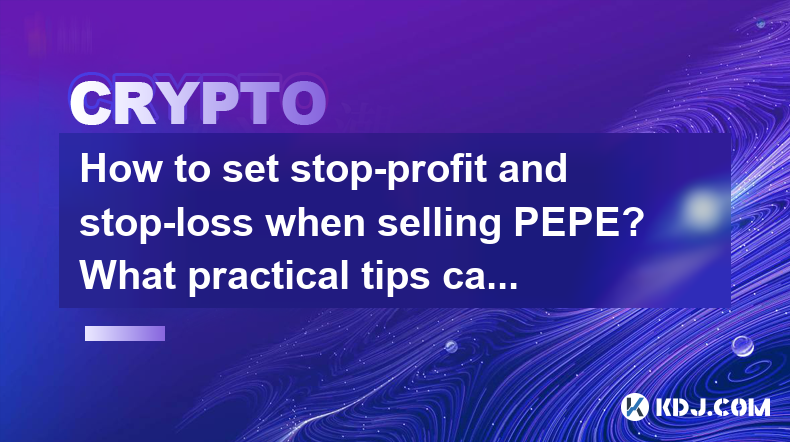
When trading cryptocurrencies like PEPE, setting stop-profit and stop-loss orders is crucial for managing risk and securing profits. These tools help automate your trading strategy, allowing you to set predetermined points at which your positions will be closed, either to lock in gains or to minimize losses. In this article, we will explore how to set stop-profit and stop-loss orders when selling PEPE, along with practical tips to enhance your trading experience.
Understanding Stop-Profit and Stop-Loss Orders
Stop-profit orders, also known as take-profit orders, are used to automatically close a trade when the price reaches a certain level of profit. This ensures that you lock in gains without needing to monitor the market constantly. On the other hand, stop-loss orders are designed to limit potential losses by closing a trade when the price falls to a specified level. Both types of orders are essential for managing risk in volatile markets like cryptocurrency.
Setting Up Stop-Profit Orders for PEPE
To set a stop-profit order for PEPE, you need to determine the price level at which you want to sell your tokens to secure your profits. Here's how you can do it on a typical cryptocurrency exchange:
- Log into your exchange account and navigate to the trading section.
- Select the PEPE trading pair you are interested in, such as PEPE/USDT.
- Go to the order section and choose the option to place a stop-limit order.
- Set the stop price at the level where you want the order to be triggered. For example, if you bought PEPE at $0.000001 and want to secure a 20% profit, you would set the stop price at $0.0000012.
- Set the limit price, which is the price at which the order will be executed once the stop price is reached. This should be slightly lower than the stop price to ensure the order is filled. For instance, you might set the limit price at $0.00000119.
- Enter the amount of PEPE you want to sell and submit the order.
Setting Up Stop-Loss Orders for PEPE
Setting a stop-loss order for PEPE involves a similar process but focuses on limiting potential losses. Here's how to do it:
- Log into your exchange account and navigate to the trading section.
- Select the PEPE trading pair you are interested in, such as PEPE/USDT.
- Go to the order section and choose the option to place a stop-limit order.
- Set the stop price at the level where you want the order to be triggered. For example, if you bought PEPE at $0.000001 and want to limit your loss to 10%, you would set the stop price at $0.0000009.
- Set the limit price, which is the price at which the order will be executed once the stop price is reached. This should be slightly higher than the stop price to ensure the order is filled. For instance, you might set the limit price at $0.00000091.
- Enter the amount of PEPE you want to sell and submit the order.
Practical Tips for Setting Stop-Profit and Stop-Loss Orders
When setting stop-profit and stop-loss orders for PEPE, consider the following practical tips to optimize your trading strategy:
- Use Technical Analysis: Analyze the price charts and identify key support and resistance levels. Setting your stop-profit and stop-loss orders near these levels can increase the likelihood of your orders being executed at favorable prices.
- Consider Volatility: PEPE, like many cryptocurrencies, can be highly volatile. Adjust your stop-profit and stop-loss levels to account for this volatility. A wider range may prevent your orders from being triggered by minor price fluctuations.
- Monitor Market Trends: Keep an eye on broader market trends and news that could impact PEPE's price. Adjust your orders accordingly to stay aligned with the market's direction.
- Use Trailing Stops: Some exchanges offer trailing stop orders, which automatically adjust the stop price as the market price moves in your favor. This can help you lock in more significant profits while still protecting against downturns.
- Diversify Your Strategy: Don't rely solely on stop-profit and stop-loss orders. Combine them with other trading strategies, such as dollar-cost averaging or swing trading, to diversify your approach and manage risk more effectively.
Common Mistakes to Avoid
When setting stop-profit and stop-loss orders for PEPE, it's essential to avoid common pitfalls that can undermine your trading strategy:
- Setting Orders Too Tight: If your stop-profit and stop-loss levels are too close to the current price, they may be triggered by normal market fluctuations, resulting in unnecessary trades.
- Ignoring Market Conditions: Failing to adjust your orders based on current market conditions can lead to missed opportunities or increased losses.
- Overtrading: Relying too heavily on stop-profit and stop-loss orders can lead to overtrading, which can increase transaction costs and reduce overall profitability.
- Neglecting to Review Orders: Regularly review and adjust your stop-profit and stop-loss orders to ensure they remain aligned with your trading goals and market conditions.
Practical Example of Setting Stop-Profit and Stop-Loss Orders for PEPE
Let's walk through a practical example of setting stop-profit and stop-loss orders for PEPE. Suppose you bought 100,000 PEPE tokens at $0.000001 each, and you want to secure a 20% profit while limiting your potential loss to 10%.
Stop-Profit Order:
- Stop Price: $0.0000012 (20% above your purchase price)
- Limit Price: $0.00000119
- Amount: 100,000 PEPE
Stop-Loss Order:
- Stop Price: $0.0000009 (10% below your purchase price)
- Limit Price: $0.00000091
- Amount: 100,000 PEPE
By setting these orders, you ensure that your position will be closed automatically if the price reaches either your desired profit or loss threshold, helping you manage your risk effectively.
Frequently Asked Questions
Q: Can I set stop-profit and stop-loss orders on all cryptocurrency exchanges?
A: Not all cryptocurrency exchanges offer stop-profit and stop-loss orders. It's essential to check the features of your chosen exchange before trading. Popular exchanges like Binance, Coinbase Pro, and Kraken typically support these order types.
Q: What happens if the market price gaps through my stop-profit or stop-loss level?
A: If the market price gaps through your stop-profit or stop-loss level, your order may be executed at a price worse than your specified limit price. This is known as slippage and is more common in highly volatile markets. To mitigate this risk, consider setting your limit price further away from the stop price.
Q: How often should I adjust my stop-profit and stop-loss orders?
A: The frequency of adjusting your stop-profit and stop-loss orders depends on your trading strategy and market conditions. It's a good practice to review your orders daily or whenever there are significant market movements to ensure they remain aligned with your goals.
Q: Can I use stop-profit and stop-loss orders for long-term investments in PEPE?
A: While stop-profit and stop-loss orders are typically used for short-term trading, they can also be applied to long-term investments. However, you may need to set wider ranges to account for the increased volatility and time frame associated with long-term holdings.
Disclaimer:info@kdj.com
The information provided is not trading advice. kdj.com does not assume any responsibility for any investments made based on the information provided in this article. Cryptocurrencies are highly volatile and it is highly recommended that you invest with caution after thorough research!
If you believe that the content used on this website infringes your copyright, please contact us immediately (info@kdj.com) and we will delete it promptly.
- Bitcoin's Pattern Break: Are HODLers the Key to the Next Surge?
- 2025-07-04 18:50:12
- Bitcoin Price, Trump's Bill, and the $150K Dream: A NYC Take
- 2025-07-04 19:50:12
- Ethereum, LILPEPE, and the July Bounce: Will Pepe Steal ETH's Thunder?
- 2025-07-04 19:10:12
- Binance Institutional Loans: Unlocking 4x Leverage and Zero Interest for Whales
- 2025-07-04 19:15:12
- Bitcoin Bull Run: Analysts Eye Peak in Late 2025?
- 2025-07-04 19:20:13
- Pepe Indicators, Bullish Forecast: Can the Meme Coin Rally?
- 2025-07-04 19:25:12
Related knowledge
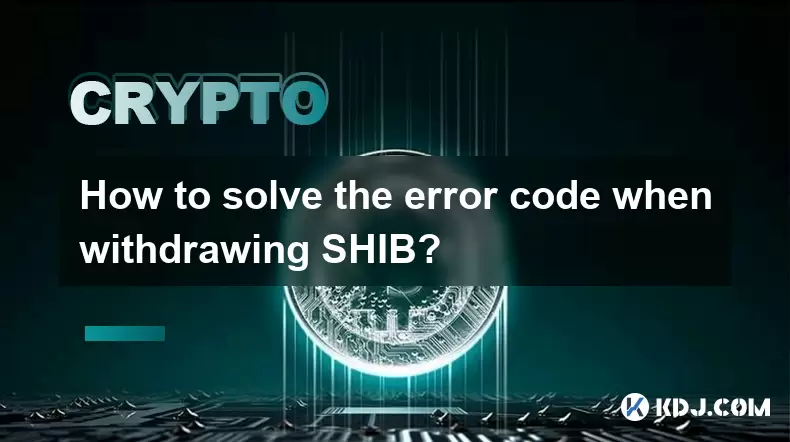
How to solve the error code when withdrawing SHIB?
May 14,2025 at 02:22am
Understanding Error Codes When Withdrawing SHIBWhen you attempt to withdraw Shiba Inu (SHIB) from an exchange or wallet, you might encounter various error codes. Understanding these error codes is crucial to successfully completing your transactions. Error codes are typically generated to inform users of specific issues that need to be addressed before ...

Can the SHIB withdrawal address be reused? Is it safe?
May 13,2025 at 04:42pm
Introduction to SHIB Withdrawal AddressesWhen it comes to Shiba Inu (SHIB) transactions, one of the critical aspects users need to understand is the nature and safety of withdrawal addresses. The SHIB withdrawal address plays a pivotal role in ensuring that your tokens are transferred securely from one wallet to another. A common question among users is...

What is the minimum withdrawal amount for SHIB? Is there a threshold?
May 13,2025 at 03:29pm
When it comes to withdrawing SHIB (Shiba Inu) from various cryptocurrency platforms, understanding the minimum withdrawal amount and any associated thresholds is crucial for managing your transactions efficiently. This article will delve into the specifics of SHIB withdrawals, focusing on the minimum amounts required, how these thresholds are set, and w...
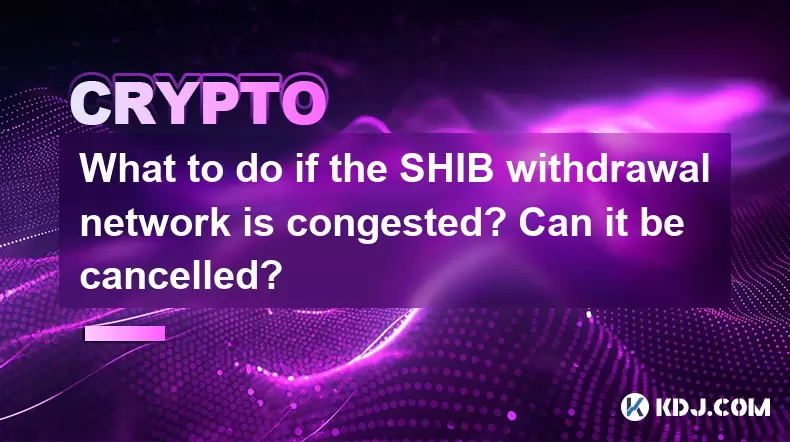
What to do if the SHIB withdrawal network is congested? Can it be cancelled?
May 13,2025 at 05:07pm
If you're facing issues with the SHIB withdrawal network being congested, it's important to understand your options and the steps you can take. Congestion in the network can lead to delays in transaction processing, and knowing whether you can cancel a pending transaction is crucial. Let's explore this topic in detail. Understanding SHIB Withdrawal Netw...
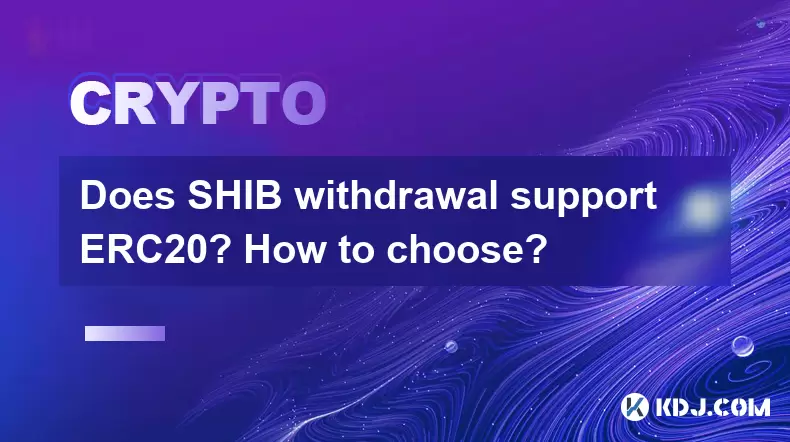
Does SHIB withdrawal support ERC20? How to choose?
May 14,2025 at 02:56am
Does SHIB withdrawal support ERC20? How to choose? Shiba Inu (SHIB) is a popular cryptocurrency that often raises questions about its withdrawal options, particularly in relation to the ERC20 token standard. This article will explore whether SHIB withdrawal supports ERC20 and provide a detailed guide on how to choose the best withdrawal method for your ...
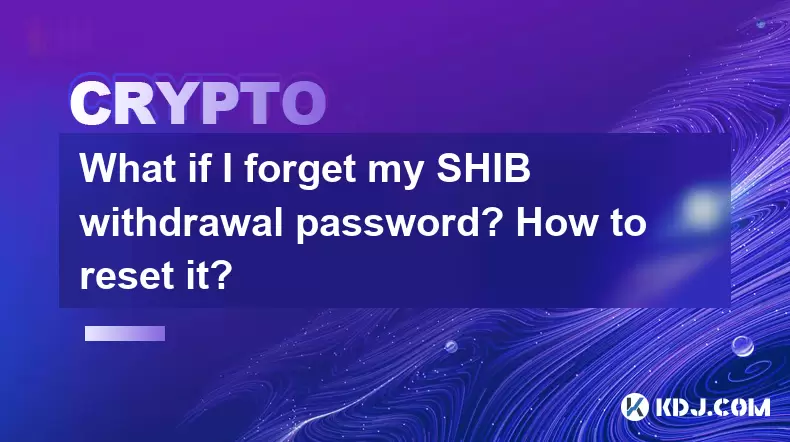
What if I forget my SHIB withdrawal password? How to reset it?
May 13,2025 at 03:15pm
Forgetting your SHIB withdrawal password can be a stressful experience, especially if you are eager to access your funds. Fortunately, there are steps you can take to reset your password and regain access to your SHIB. This article will guide you through the process of resetting your SHIB withdrawal password, ensuring that you can continue to manage you...

How to solve the error code when withdrawing SHIB?
May 14,2025 at 02:22am
Understanding Error Codes When Withdrawing SHIBWhen you attempt to withdraw Shiba Inu (SHIB) from an exchange or wallet, you might encounter various error codes. Understanding these error codes is crucial to successfully completing your transactions. Error codes are typically generated to inform users of specific issues that need to be addressed before ...

Can the SHIB withdrawal address be reused? Is it safe?
May 13,2025 at 04:42pm
Introduction to SHIB Withdrawal AddressesWhen it comes to Shiba Inu (SHIB) transactions, one of the critical aspects users need to understand is the nature and safety of withdrawal addresses. The SHIB withdrawal address plays a pivotal role in ensuring that your tokens are transferred securely from one wallet to another. A common question among users is...

What is the minimum withdrawal amount for SHIB? Is there a threshold?
May 13,2025 at 03:29pm
When it comes to withdrawing SHIB (Shiba Inu) from various cryptocurrency platforms, understanding the minimum withdrawal amount and any associated thresholds is crucial for managing your transactions efficiently. This article will delve into the specifics of SHIB withdrawals, focusing on the minimum amounts required, how these thresholds are set, and w...

What to do if the SHIB withdrawal network is congested? Can it be cancelled?
May 13,2025 at 05:07pm
If you're facing issues with the SHIB withdrawal network being congested, it's important to understand your options and the steps you can take. Congestion in the network can lead to delays in transaction processing, and knowing whether you can cancel a pending transaction is crucial. Let's explore this topic in detail. Understanding SHIB Withdrawal Netw...

Does SHIB withdrawal support ERC20? How to choose?
May 14,2025 at 02:56am
Does SHIB withdrawal support ERC20? How to choose? Shiba Inu (SHIB) is a popular cryptocurrency that often raises questions about its withdrawal options, particularly in relation to the ERC20 token standard. This article will explore whether SHIB withdrawal supports ERC20 and provide a detailed guide on how to choose the best withdrawal method for your ...

What if I forget my SHIB withdrawal password? How to reset it?
May 13,2025 at 03:15pm
Forgetting your SHIB withdrawal password can be a stressful experience, especially if you are eager to access your funds. Fortunately, there are steps you can take to reset your password and regain access to your SHIB. This article will guide you through the process of resetting your SHIB withdrawal password, ensuring that you can continue to manage you...
See all articles

























































































